Colus hirudinosus A. Cavalier & P. Séchier
Phylum: Basidiomycota - Class: Agaricomycetes - Order: Phallales - Family: Phallaceae
Distribution - Taxonomic History - Etymology - Identification - Reference Sources
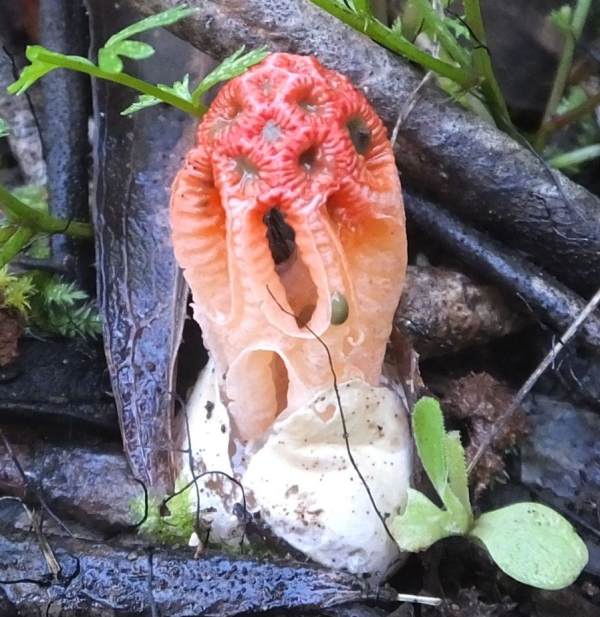
Colus hirudinosus is one of the world's smallest stinkhorn fungi, and so, despite its bold colours, it is easily overlooked. This is just one of many strange stinkhorns which produce smelly spore-laden gleba that attracts flies. The flies eat what they can of the gleba, but enough spore-laden slime sticks to their feet so that as they fly off and alight elsewhere the spores are distributed to potential new territory for this fungal species. This process must be effective, because just like the insects that serve as their spore-distribution couriers, the various cage-like stinkhorn fungi found throughout tropical and sub-tropical climes do not appear to be in any real danger of extinction.There are several genera of cage-like fungi including Colus, Clathrus, Ileodictyon and Lysurus.
The pictures on this page show mature fruitbodies growing in their typical habitat of rotting leaves.
Distribution
Not found in Britain this diminutive stinkhorn is is found mainly in southern Europe, northern Africa and parts of Asia. This species has also been recorded in Australia. The type specimen came from southern France. The pictures shown on this page were taken in the Algarve region of southern Portugal in early February 2024.
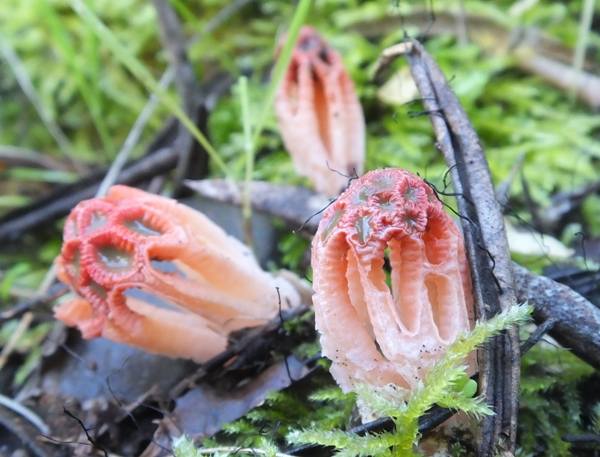
Taxonomic history
First described scientifically in 1835 by French mycologists A. Cavalier & P. Séchier, who established its basionym as Colus hirudinosus, the accepted scientific name is of this stinkhorn fungus remains unaltered.
Etymology
The generic name Colus is Latin and means distaff - a fusiform tool used in spinning and the form of this fungus fruitbody when it is young. (In much the same vein, the gastropod Colus islandicus has a distaff-shaped shell.)
The specific epithet hirudinosus may be a reference to the flattened leech-like form of the columns of the fruitbody.
Identification guide
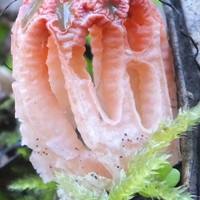 |
FruitbodyInitially appearing as a half-buried whitish orvery pale brown ball or 'egg' up to 2cm in diameter, the lattice-like form of this fungus becomes visible only once the outer membrane of the egg bursts. Fruitbodies erupt and then collapse in a few days. Typically 1 to 2.5cm across and 2 to 5cm tall when fully mature, the fruitbody sits on a very short white stem and comprises a vertically elongated or ovoid cage. The lower part of the cage is open and consists of 4 to 6 pale pink corrugated arms. |
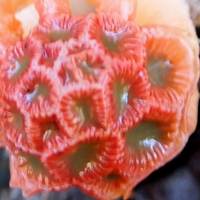 |
The top of the fruitbody consists of a darker red lattice whose apertures are filled with olive-coloured smelly gleba that attracts flies. The gleba sticks to the legs of the flies and is carried away to another location, where a new stinkhorn colony might result. |
SporesSubcylindrical, smooth, 3-5 x 1.5-2µm; hyaline. (Spores are embedded in a dark olive gleba.) Spore printOlive-brown. |
|
Odour/taste |
Strong, unpleasant odour. Taste not documented... at least, I can't find anyone who has tried it!. |
Habitat & Ecological role |
Saprobic, in rotting leaf litter, often with Cistus species. |
Season |
These stinkhorns can appear at almost any time of year if the weather is sufficiently warm and wet. In the Mediterranean that generally means between October and March. |
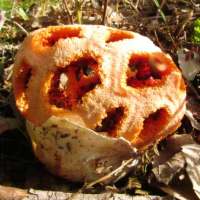 |
Similar speciesClathrus ruber, which occurs in Europe (including Britain) is of similar form but it has an open cage structure and is much larger. Its cage structure is more irregular and does not display the currugations that are characteristic of Colus hirudinosus. |
Reference Sources
Cavalier A, Séchier P (1835). "Description d'une nouvelle espèce de Champignon". Annales des Sciences Naturelles, Botanique. 3 (2): 251–4.
Colus hirudinosus (Berk.) Reichert, Palest. J. Bot., R. Ser.: 190 (1940)
Dictionary of the Fungi; Paul M. Kirk, Paul F. Cannon, David W. Minter and J. A. Stalpers; CABI, 2008
Taxonomic history and synonym information on these pages is drawn from many sources but in particular from the British Mycological Society's GB Checklist of Fungi.
Acknowledgements
This page includes pictures kindly contributed by Patrea Andersen.
Fascinated by Fungi. Back by popular demand, Pat O'Reilly's best-selling 450-page hardback book is available now. The latest second edition was republished with a sparkling new cover design in September 2022 by Coch-y-Bonddu Books. Full details and copies are available from the publisher's online bookshop...

